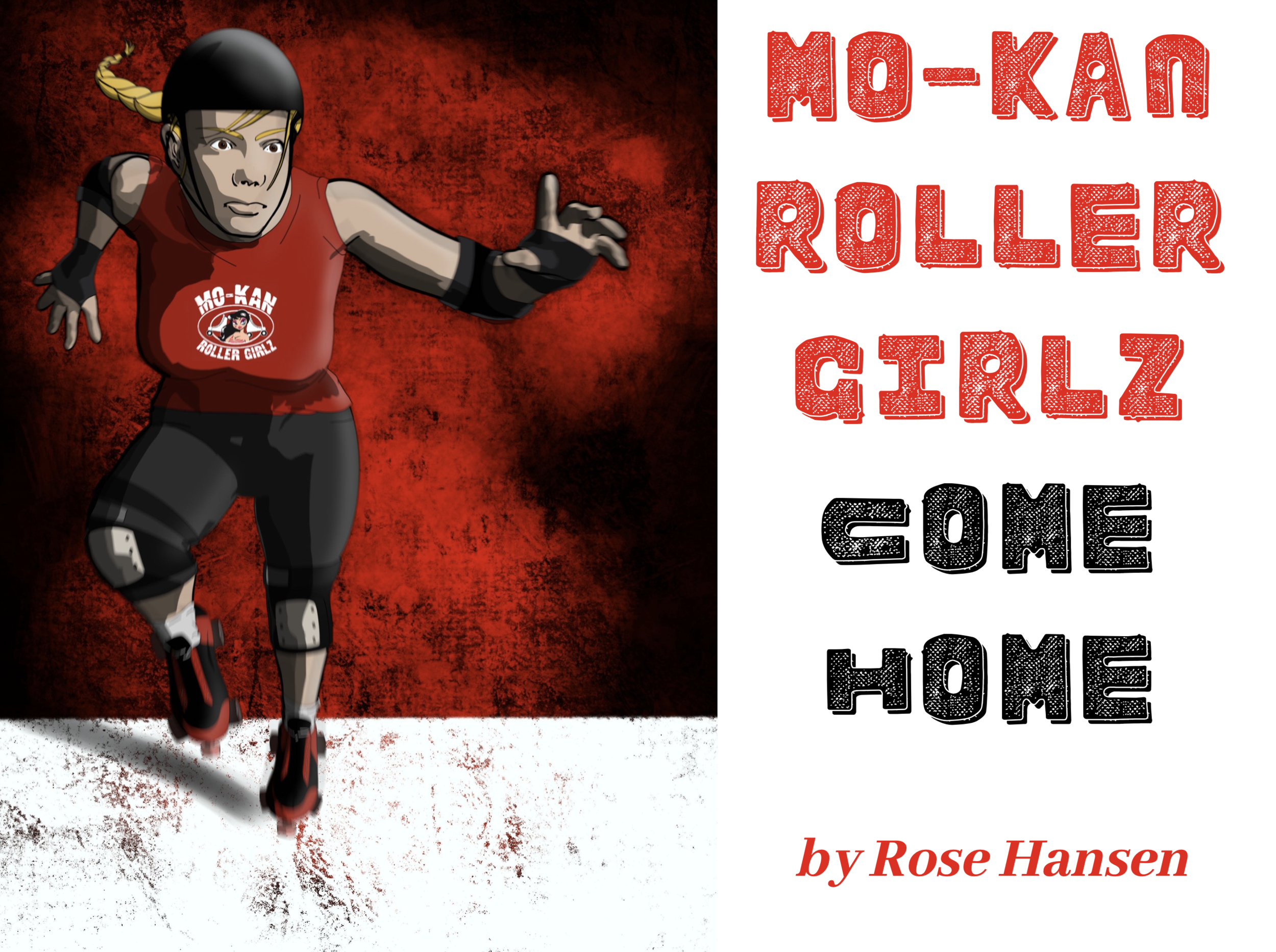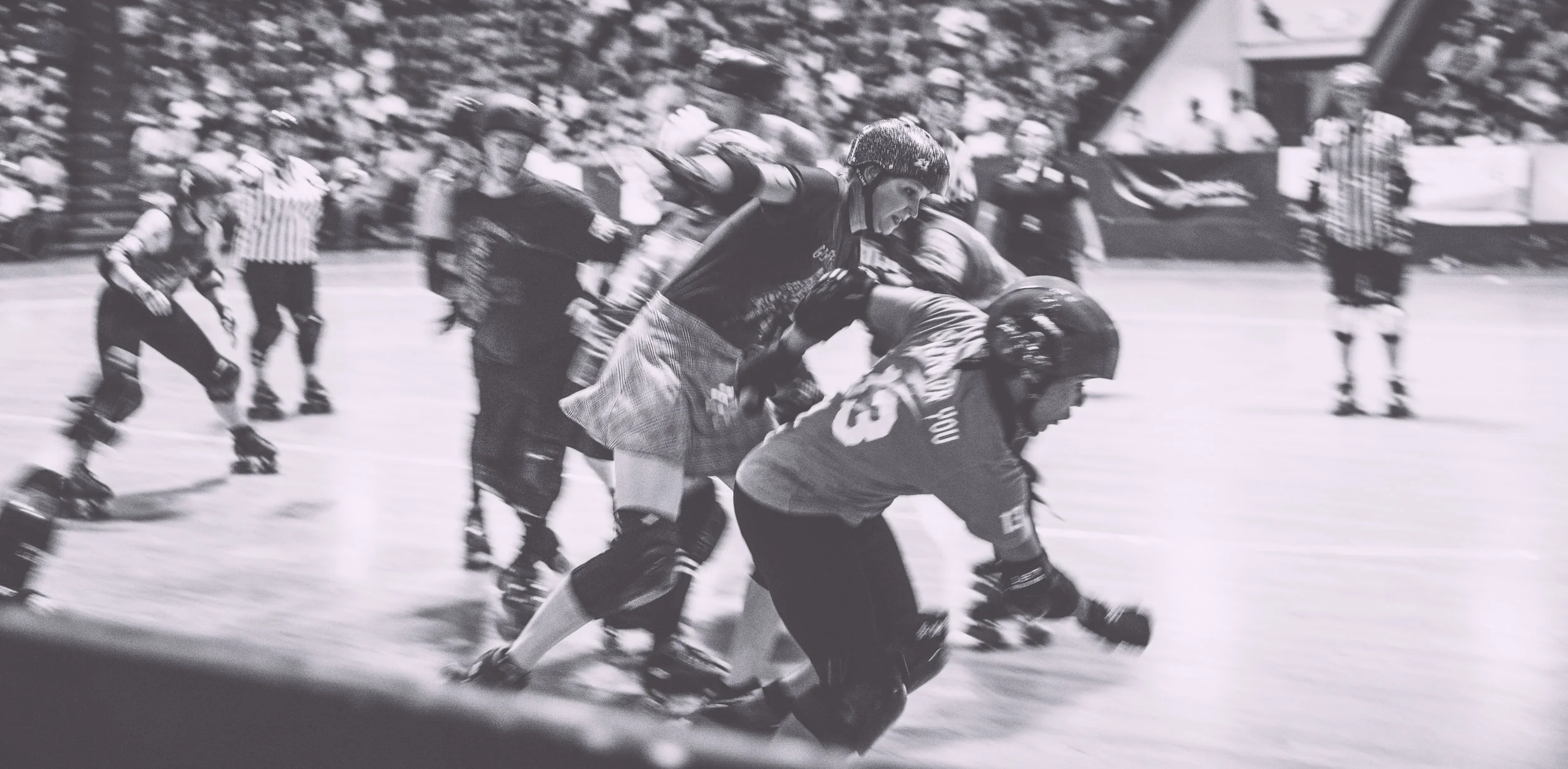Mo-Kan Roller Girlz Come Home (ARTICLE)
illustration by Austin Spencer
By Rose Hansen
By day, they’re ordinary women: fitness instructors, stay-at-home mothers, students, preachers’ wives. But twice a week, they shed these responsibilities at the Spinning Wheels Skate Center in Carl Junction. They velcro pads around their knees and fasten helmet straps under their chins. They slip mouthguards between their teeth. They become the Mo-Kan Roller Girlz.
As Brandee “Neurotica 911” Read laces up her skates, she complains about her knees, which ache from her recent career shift to become a fitness instructor. “After thirteen years of roller derby, [knees] are the only thing that never hurt,” says Read, who co-founded Mo-Kan Roller Girlz with former teammates Tracy Brewer, Shannon Lowery and Angela McPhail in 2007.
photo by Matt Winkfield
Calling the sport physical is a euphemism. Roller derby is brutal. Players twist their ankles, hit their heads, slam against one another. And since they’re on skates, of course, they fall. Often. Participation numbers vary. Ideally, roller derby teams have at least 15 members. On this particular night in August, only six make it to practice. It doesn’t worry Read or Coach Doug Whitten, who has led the team for over a decade. There are bigger things to focus on than on attendance.
The Mo-Kan Roller Girlz last played in Joplin two years ago, but they’re finally coming home. This is their 12th season, and they’re celebrating by playing against the St. Louis Fleur DeLinquents at Joplin’s Memorial Hall on September 7th. Showcasing both athletic prowess and spectacle, their games draw hundreds. At their last home event in 2017, organizers started turning people away after 500.
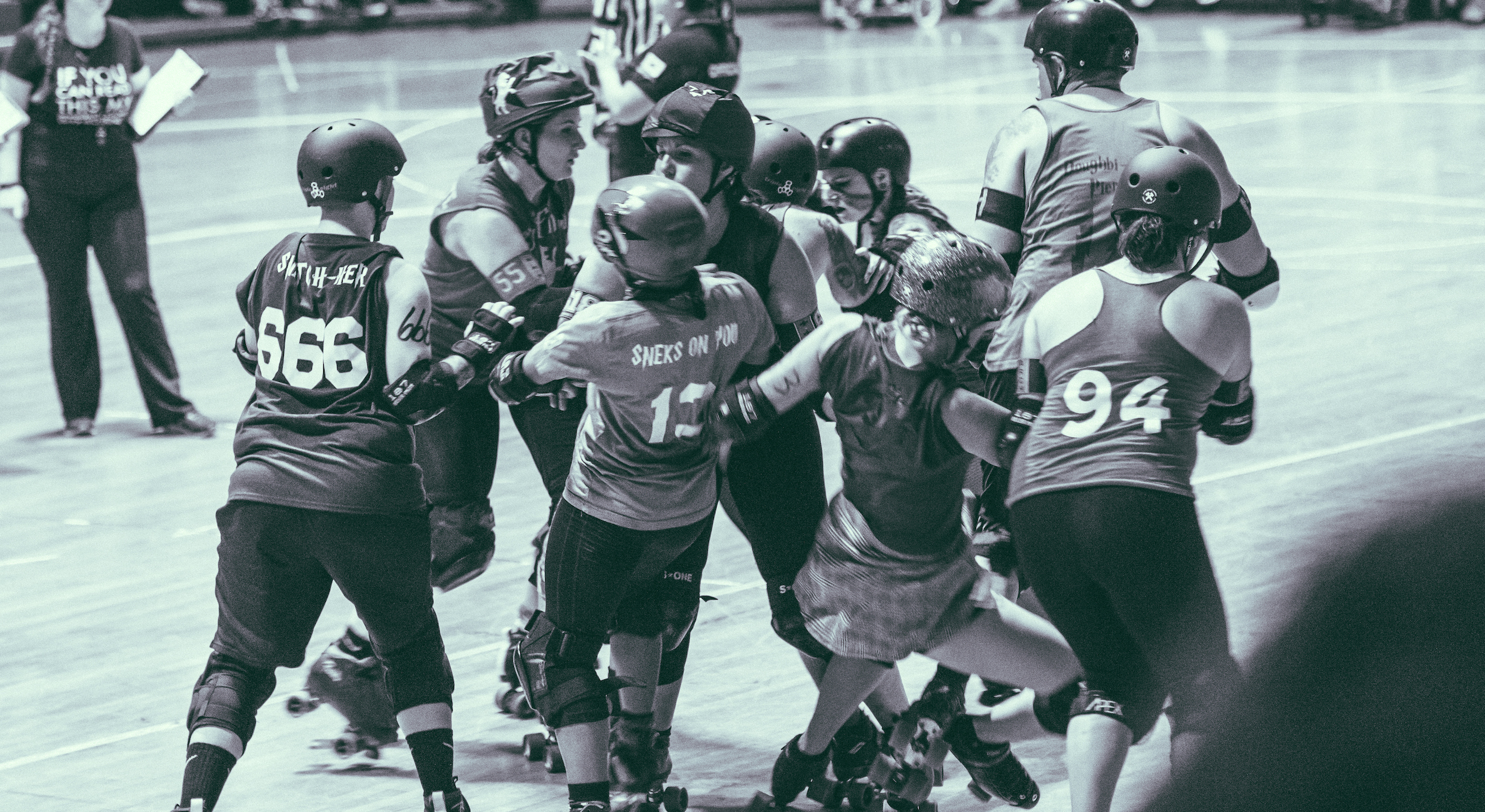
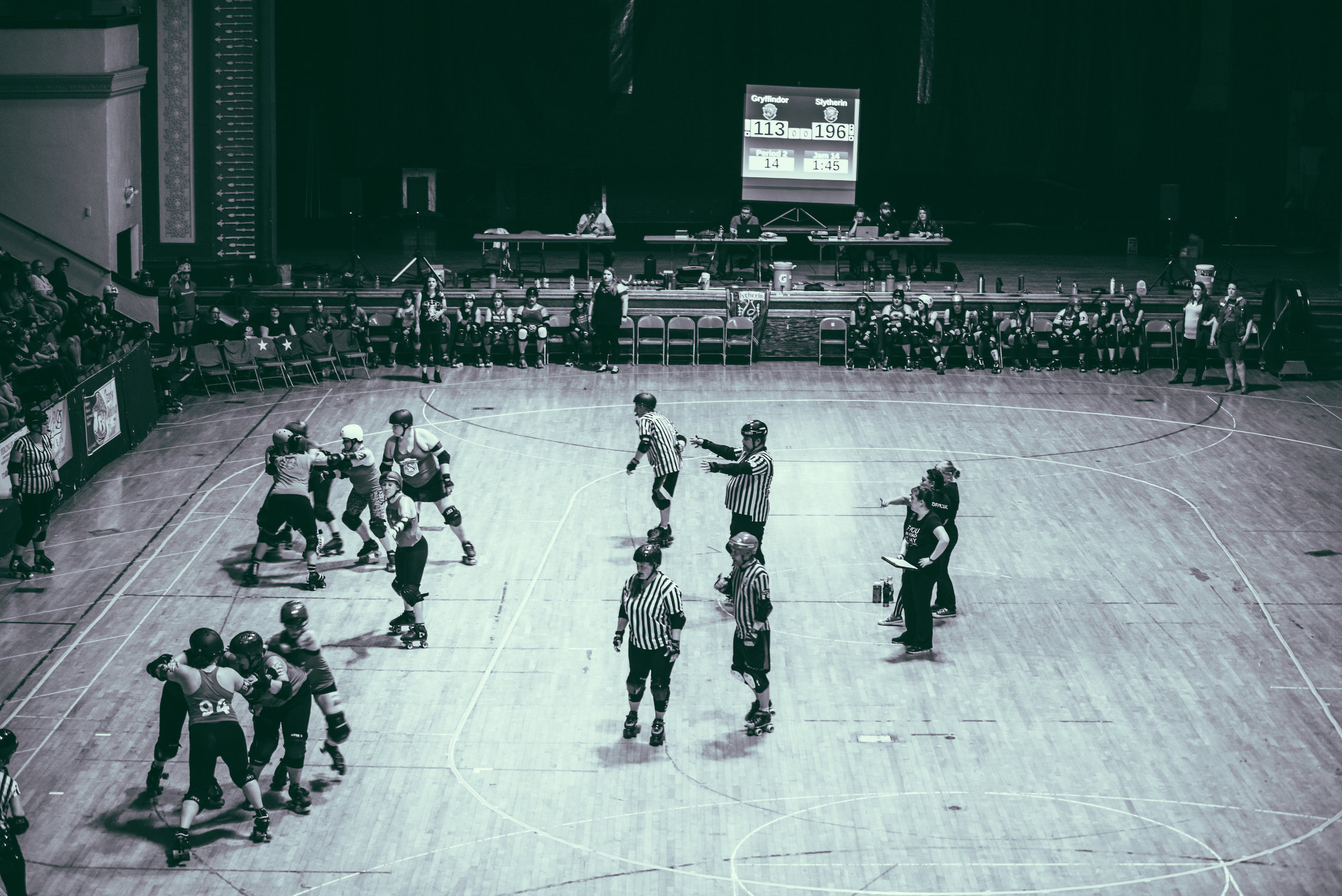
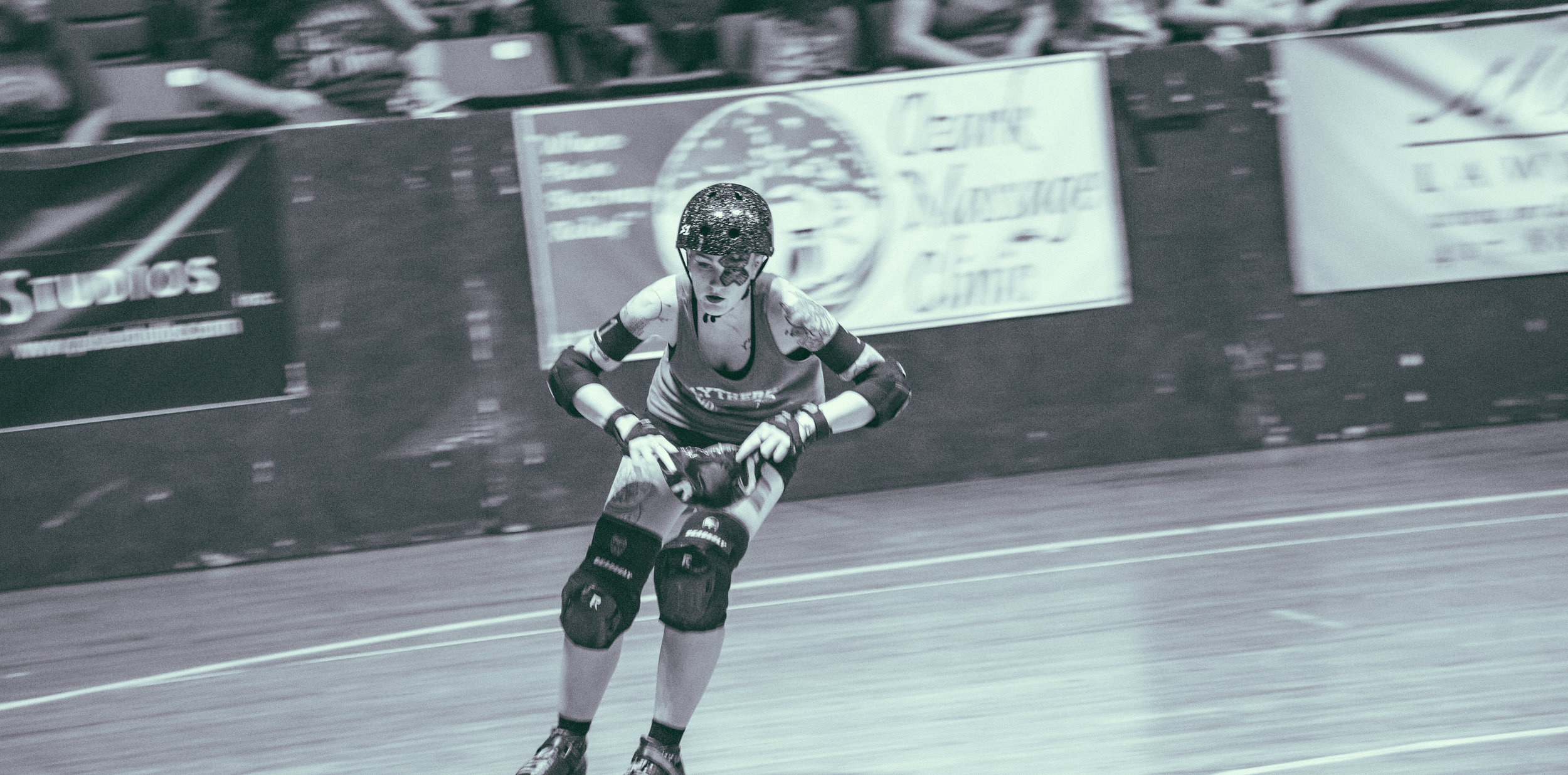
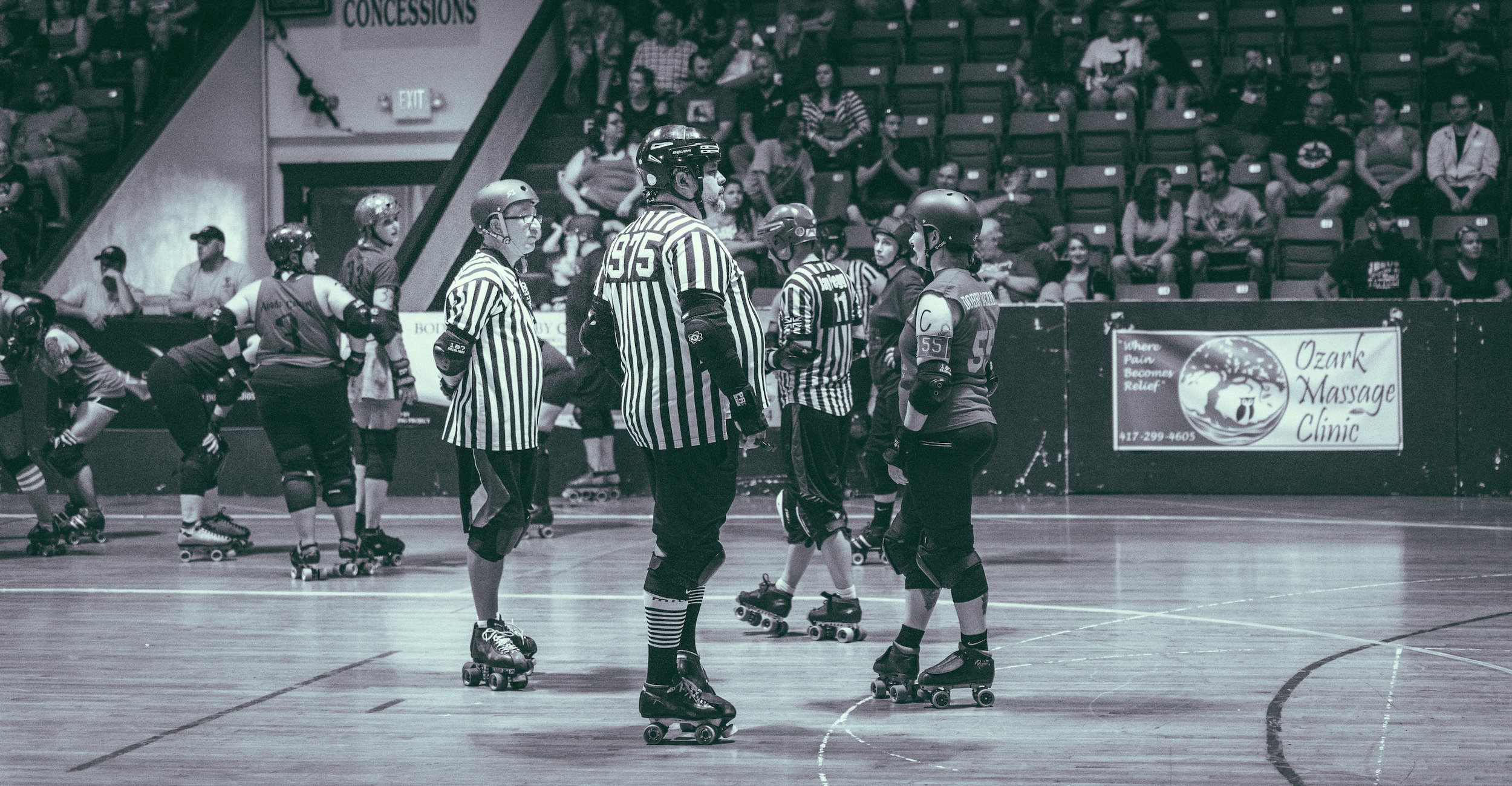
photos by Matt Winkfield
At the Spinning Wheels Skate Center, neon skate murals adorn the walls. A silver disco ball hangs over the rink. The athletes warm up by skating languid laps around an oval marked with small yellow cones. They coast and chat, make jokes, bump shoulders. Sometimes they skate backwards. Nearly all have tattoos, piercings, or both. Some are sinewy and lean, others more muscular and full-figured.
“It’s an empowering sport and it’s awesome being around such strong women,” says first-year Cynthia “Cyn City” Torres. Then she loses her balance and falls to her knees. “Whoops!” she says, popping back up, unfazed. Her pink mouthguard gleams when she smiles.
After warm up, they run a skate/squat/sit-up drill. A lithe blonde named Ashley “Skayter Moon” Bates shrieks to a stop and drops into sit-ups. She began playing roller derby eight years ago. “A friend took me to a roller derby game in Cape Girardeau. I went, ‘Yup. That’s what I want to do,” Bates recalls. Next comes footwork—shuffles, ladders, grapevines. The skates clatter on the rink. Finally, Whitten whistles for a one-minute break. Panting, they coast to a half wall where their water bottles wait.
“A lot of people still don’t know about us,” says Read. “Over the years I’ve known all kinds of women who play—shy, quiet ones, loud, obnoxious ones, teachers, preachers’ wives… I was a homeschooling mom when I started our league. Once you play roller derby, you either love it or you don’t care about it. There is no in-between. It becomes your life.”
At first, Read was attracted to roller derby for its physicality. “I was looking for a way to beat people up,” she admits. “But it just became so much more. Now it’s about friends. I never dreamed I’d have the friendships that I have.”
Roller derby as a contact sport was popularized in the 1930s and thrived through the next three decades, but faded from the public eye until its revival in 2002 by The Texas Rollergirls. Since then, amateur roller derby leagues have been springing up nationwide.
Games are divided into two 30-minute sections, with each split into two-minute “jams.” During a jam, each team uses five players—four “blockers” and one point-scoring “jammer.” Jammers begin by skating behind the opposing team’s blockers, scoring a point for every time they lap. Passing blockers, though, usually requires slamming into a wall of players to break through, or maneuvering around on the edges of the track.
Ideally, a team has enough players to rotate in and out, giving them a chance to catch their breath. But what if, like at tonight’s practice, they’re short a few teammates?
“We get tired,” Captain Melody “Mel Diablo” McDannall says.
“We always make it work,” Whitten says quickly.
The second half of practice is dedicated to jamming and blocking. Now, practice begins resembling what spectators usually see during a game. They run drills dragging one another to a stop. Next comes blocking technique, where two players press the sides of their bodies together to prevent a jammer from breaking through. They pair up.
“You ready to snuggle?” Bates asks, squatting low.
Leray “Balls” Caldwell nods and grins, baring her black mouth guard. “Let’s snuggle.”
They press their hips and shoulders together and skate forward. “Nice seal,” Whitten says.
For jamming, the designated skater slips on a black cap with red stars. Everyone moves into formation. Bates slams into the blockers, muscles flexed as she wedges between them, then shifts to the side to try skating around. Someone hip checks her. Again and again, the players rotate out, practicing different positions. Again and again, someone slams into the wall, or loses their balance and falls.
It’s no secret that roller derby is an outlet for aggression that, in everyday life, few women feels free to express. 2019 marks Caldwell’s fourth season of roller derby, and she’s frank about what motivated her to join. “It was an out. Something to do for myself without my children and my spouse. And so I could hit a bitch and not go to jail.”
Whitten pauses practice to reflect on a recent loss against the 580 Rollergirls from Lawton, Oklahoma, who won by just five points. Nodding, he says, “That was a good game for us to learn from.”
“That was the last time they’re gonna win,” Read says.
The secret, Whitten explains, is to sharpen their offense. They practice a play where jammers can call for backup, pulling blockers away from their seals to distract the opposing team. At first, the runs are chaotic, and there’s a lot of laughter.
Jessica “Hott Rod Havoc” Vann Oster began playing roller derby in Tulsa more than a decade ago, but joined Mo-Kan Roller Girlz in 2012 after relocating to the area. “It’s like a sisterhood,” she says, smiling sweetly. “And I like the contact. The hitting.” And just like that, Vann Oster’s face hardens. She’s an effective blocker, but when it’s her turn to jam, she sweeps past her teammates. Grinning, she cries, “I learned a thing! An offense thing!” Everyone laughs and high-fives her.
Practice ends with a huddle. Next week, Whitten reminds them, Benton County will come so they can practice scrimmaging. The women are still panting. Sweat gleams on their skin. Their shoulders nearly touching, they lay their hands over one another and shout:
“One, two, three—MO-KAN!”
photo by Mark Neuenschwander
editors note: This feature was written before the game referenced in the article- we’re happy to report the Mo-kan Girlz won by a landslide. We also want to mention that the photos shown here are not all recent- members of the league change out on a regular basis, so some of the ladies pictured are not currently on the team.
If YOU want to keep track of the team in anticipation of their next season beginning in January, they have big things ahead and now is a great time to follow them at their facebook page.

